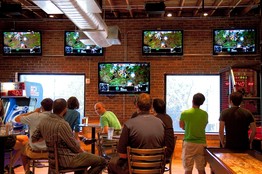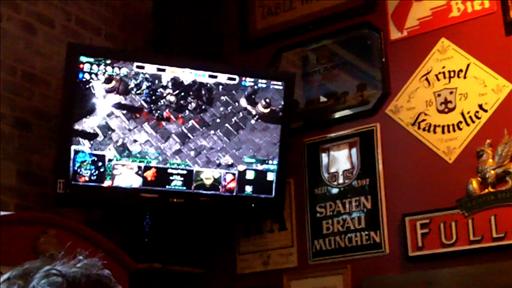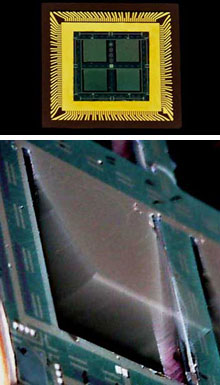Via
The Wall Street Journal
-----
SAN FRANCISCO—One Sunday afternoon last month, a hundred boisterous
patrons crowded into Mad Dog in the Fog, a British sports bar here, to
watch a live broadcast.
Internet e-sports like Starcraft2 have
big-name pro players, announcers who broadcast matches, and millions of
fans who'd rather watch the action online or in bars than play
themselves. WSJ's Amir Efrati reports.
Half the
flat-screen TVs were tuned to a blood-filled match between two Korean
competitors, "MC" and "Puma." The crowd erupted in chants of "M-C! M-C!"
when the favorite started a comeback.
The pub is known for
showing European soccer and other sports, but Puma and MC aren't
athletes. They are 20-year-old professional videogame players who were
leading computerized armies of humans and aliens in a science-fiction
war game called "Starcraft II" from a Los Angeles convention center. The
Koreans were fighting over a tournament prize of $50,000.
This summer, "Starcraft II" has become
the newest barroom spectator sport. Fans organize so-called Barcraft
events, taking over pubs and bistros from Honolulu to Florida and
switching big-screen TV sets to Internet broadcasts of professional game
matches happening often thousands of miles away.

Fans of 'Starcraft II' watch a live game broadcast in Washington, D.C.
As
they root for their on-screen superstars, "Starcraft" enthusiasts can
sow confusion among regular patrons. Longtime Mad Dog customers were
taken aback by the young men fist-pumping while digital swarms of an
insect-like race called "Zerg" battled the humanoid "Protoss" on the
bar's TVs.
"I thought I'd come here for a quiet
beer after a crazy day at work," said Michael McMahan, a 59-year-old
carpenter who is a 17-year veteran of the bar, over the sound of noisy
fans as he sipped on a draught pint.
But for sports-bar owners, "Starcraft"
viewers represent a key new source of revenue from a
demographic—self-described geeks—they hadn't attracted before.
"It was unbelievable," said Jim
Biddle, a manager of Bistro 153 in Beaverton, Ore., which hosted its
first Barcraft in July. The 50 gamers in attendance "doubled what I'd
normally take in on a normal Sunday night."
For "Starcraft" fans, watching in bars
fulfills their desire to share the love of a game that many watched at
home alone before. During a Barcraft at San Francisco's Mad Dog in July,
Justin Ng, a bespectacled 29-year-old software engineer, often rose to
his feet during pivotal clashes of a match.
"This
feels like the World Cup," he said. "You experience the energy and
screams of everyone around you when a player makes an amazing play."
Millions of Internet users already
tune in each month on their PCs to watch live "eSports" events featuring
big-name stars like MC, who is Jang Min Chul in real life, or replays
of recent matches.
In the U.S., fervor for "Starcraft II"
is spilling into public view for the first time, as many players now
prefer to watch the pros. In mid-July, during the first North American
Star League tournament in Los Angeles, 85,000 online viewers watched
Puma defeat MC in the live championship match on Twitch.tv, said Emmett
Shear, who runs the recently-launched site.
The "Starcraft" franchise is more
popular in Korea, where two cable TV stations, MBC Game and Ongamenet,
provide dedicated coverage. The cable channels and Web networks
broadcast other war games such as "Halo," "Counter-Strike," and "Call of
Duty." But "Starcraft II" is often the biggest draw.
The pros, mostly in their teens and
20s, get prize money and endorsements. Professional leagues in the U.S.
and Korea and have sprouted since "Starcraft II" launched last year.
Pro-match broadcasts often include breathless play-by-play announcers
who cover each move like a wrestling match. (A typical commentary: "It's
a drone genocide! Flaming drone carcasses all over the place!").
Barcraft goers credit a Seattle bar,
Chao Bistro, for launching the Barcraft fad this year. Glen Bowers, a
35-year-old Chao patron and "Starcraft" fan, suggested to owner Hyung
Chung that he show professional "Starcraft" matches. Seeing that
customers were ignoring Mariners baseball broadcasts on the bar's TVs,
Mr. Chung, a videogame fan, OK'ed the experiment.
In mid-May Mr. Bowers configured
Chao's five TVs to show Internet feeds and posted an online notice to
"Starcraft" devotees. About 150 people showed up two days later. Since
then, Mr. Bowers has organized twice-a-week viewings; attendance has
averaged between 40 and 50 people, including employees of Amazon.com Inc. and Microsoft Corp., he said.
The trend ended up spreading to more than a dozen Barcrafts across the country, including joints in Raleigh, N.C., and Boston.
The "Starcraft II" game lends itself to
sports bars because it "was built from the ground up as a spectator
sport," said Bob Colayco, a publicist for the game's publisher, Activision Blizzard Inc. Websites like Twitch.tv helped "Starcraft's" spectator-sport appeal by letting players "stream" live games.
Two University of Washington graduate
students recently published a research paper seeking to scientifically
pinpoint "Starcraft's" appeal as a spectator sport. The paper posits
that "information asymmetry," in which one party has more information
than the other, is the "fundamental source of entertainment."



